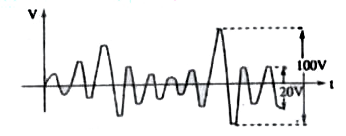A sinusoidal wave with amplitude ym is travellling with speed V on a stgring with linear density ρ. The angular frequency of the wave is ω. The following conclusions are down. Mark the one which is correct.
Doubling the frequency doubles the rate at which energy is carried along the string.
If the amplitude were doubled, the rate at which energy is carried would be halved
If the amplitude were doubled, the rate at which energy is carried would be doubled
The rate at which energy is carried is directly proportional to the velocity of the wave
The correct Answer is:D
To solve the problem, we need to analyze the relationship between the various parameters of a sinusoidal wave traveling on a string. The key parameters given are:
- Amplitude of the wave: ym
- Speed of the wave: V
- Linear density of the string: ρ
- Angular frequency of the wave: ω
We will derive the expression for the average power carried by the wave and analyze the options provided.
Step 1: Understand the formula for power in a wave
The average power P carried by a sinusoidal wave on a string can be expressed as:
P=12μω2A2V
where:
- μ is the linear density of the string (ρ),
- ω is the angular frequency,
- A is the amplitude of the wave,
- V is the speed of the wave.
Step 2: Analyze the effect of doubling frequency
If we double the angular frequency (ω→2ω):
P′=12μ(2ω)2A2V=12μ(4ω2)A2V=4(12μω2A2V)=4P
This shows that doubling the frequency increases the power by a factor of 4.
Step 3: Analyze the effect of doubling amplitude
If we double the amplitude (A→2A):
P′=12μω2(2A)2V=12μω2(4A2)V=4(12μω2A2V)=4P
This shows that doubling the amplitude also increases the power by a factor of 4.
Step 4: Analyze the effect of doubling both frequency and amplitude
If we double both frequency and amplitude:
P′=12μ(2ω)2(2A)2V=12μ(4ω2)(4A2)V=16P
This shows that doubling both frequency and amplitude increases the power by a factor of 16.
Step 5: Analyze the effect of velocity
The power is directly proportional to the wave speed V:
P∝V
If the speed of the wave increases, the power carried by the wave also increases proportionally.
Conclusion
Now, we analyze the options:
- Option A: Doubling the frequency increases power by a factor of 4 (not correct).
- Option B: Doubling the amplitude increases power by a factor of 4 (not correct).
- Option C: Doubling the amplitude does not double the power (not correct).
- Option D: The rate at which energy is carried is directly proportional to the velocity of the wave (correct).
Thus, the correct conclusion is Option D.
- Speed of the wave: V
- Linear density of the string: ρ
- Angular frequency of the wave: ω
The average power P carried by a sinusoidal wave on a string can be expressed as:
P=12μω2A2V
where:
- μ is the linear density of the string (ρ),
- ω is the angular frequency,
- A is the amplitude of the wave,
- V is the speed of the wave.
If we double the angular frequency (ω→2ω):
P′=12μ(2ω)2A2V=12μ(4ω2)A2V=4(12μω2A2V)=4P
This shows that doubling the frequency increases the power by a factor of 4.
If we double the amplitude (A→2A):
P′=12μω2(2A)2V=12μω2(4A2)V=4(12μω2A2V)=4P
This shows that doubling the amplitude also increases the power by a factor of 4.
If we double both frequency and amplitude:
P′=12μ(2ω)2(2A)2V=12μ(4ω2)(4A2)V=16P
This shows that doubling both frequency and amplitude increases the power by a factor of 16.
The power is directly proportional to the wave speed V:
P∝V
If the speed of the wave increases, the power carried by the wave also increases proportionally.
Now, we analyze the options:
- Option A: Doubling the frequency increases power by a factor of 4 (not correct).
- Option B: Doubling the amplitude increases power by a factor of 4 (not correct).
- Option C: Doubling the amplitude does not double the power (not correct).
- Option D: The rate at which energy is carried is directly proportional to the velocity of the wave (correct).
Similar Questions
A transverse wave of amplitude 2 m, wavelength 4 m and frequency 6 Hz is propagating in a string toward positive y-direction. The equation of the wave may be (y is in m and t is in s)
View SolutionSinusoidal waves 5.00 cm in amplitude are to be transmitted along a string that has a linear mass density of 4.00×10−2kg/m. The source can deliver a macimum power of 300 W and the string is under a tesion of 100 N. what is the highest frequancy at which the source can operate?
View Solution
Knowledge Check
The amplitude of em wave in vacuum is doubled with no other changes made to wave. As a result of this doubling of the amplitude, which of the following statement is correct.
AThe speed of wave propagation changes onlyBThe frequency of the wave change onlyCThe wavelength of the wave changes onlyDNone of these
The amplitude modulated signal consists of two sinusoidal waves of frequencies, (ωc→angular frequency of carrier wave) (ωm→angular frequency of modulating signal)
View SolutionThree sinusoidal waves having same frequency have amplitudes in the ratio 6:3:2 and their phases are 0,π2,π . If 6a be the amplitude of the first wave , then which of the following is not correct
View SolutionTwo identical sinusoidal waves travel in opposite direction in a wire 15m long and produce a standing wave in the wire . If the speed of the wave is 12ms−1 and there are 6 nodes in the standing wave . Find the frequency .
View SolutionAn amplitude modulated wave is as shown in Fig.

Which of the following is/are correct ?
View SolutionWhen beats are produced by two progressive waves of nearly the same frequency, which one of the following if correct?
View SolutionSinusoidal waves 5.00 cm in amplitude are to be transmitted along a string having a linear mass density equal to 4.00×10−2kg/m.If the source can deliver a average power of 90 W and the string is under a tension of 100 N, then the highest frequency at which the source can operate is (take π2=10):
View Solution
System is shown in the figure. Velocity of sphere A is 9 ms. Find the speed of sphere B.
View Solution
